E.G. Lewis's Blog, page 9
February 7, 2012
THE TELEGRAPHIC SYSTEM USED BY THE ROMAN LEGIONS
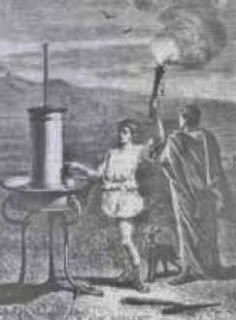 A Drawing of the System in ActionHello My Friend and Welcome.
A Drawing of the System in ActionHello My Friend and Welcome.Today we examine a system used by the Romans which allowed them to effectively coordinate military maneuvers. How? They telegraphed commands from one point to another.
Yes, we know that the telegraph was invented in 1844 by Samuel. B Morse who also, somewhat conveniently, developed a code of dots and dashes for the letters of the alphabet. But long before Morse send his famous "What hath God wrought?" message from Washington to Baltimore, other signaling systems let people communicate over distances. These were visual systems that relied on flags or lights. Messages were usually passed from one hilltop to the next via a system of relays.
COMMUNICATING DURING BABYLONIAN INVASIONWe have early evidence of such a system by the Jews. The Lachish Letters, also known as The Hoshaiah Letters are a group of letters written in carbon ink in Ancient Hebrew on pieces of fired clay…probably broken pots. They were written by Hoshaiah, a military officer stationed in a city close to Lachish to Joash, possibly the commanding officer at Lachish (modern Tell ed-Duweir). The letters, which are kept in a British Musuem, were written shortly before Lachish fell to the Babylonians in 588/6 BC during the reign Zedekiah (Jeremiah 34:7). Letter Three contains the following reference: "…And may my lord be apprised that we are watching for the fire signals of Lachish according to all the signs which my lord has given, because we cannot see Azeqah."
Similarly, the Book of Judith 7:5 states, "But in spite of their fear, all the Israelites took up their weapons, lighted signal fires on the towers, and remained on the guard duty all night."
BREAKING THE CODE
All of these systems, both modern and ancient, relied upon a pre-arranged message that instigated a predetermined action. They communicated a single fact…"The enemy has been sighted," etc. In other words, they lacked flexibility. The Romans used a system originally developed by the Greeks that surmounted this difficulty by creating a preset group of codes.
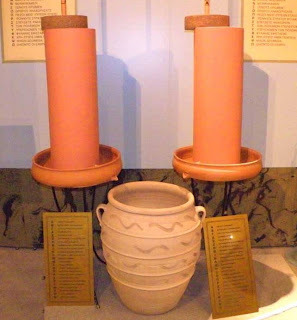 Museum Replica of the Telegraph System
Museum Replica of the Telegraph SystemThe system relied upon the fact that water drains out of two identical containers at the same rate. The sender and receiver had identical water clocks with identical rods mounted inside them. The rods had a series of marks along them, each corresponding to a different message. Each man had the same book of codes. The message was transmitted based on the time the clock was allowed to drain.
For instance, to send message VIII, the sender raised their flag or flaming torch if at night, and waited until the receiver acknowledged it. Then the sender lowered his flag or torch and raised it again, starting their clock as they did. When the sender's water level reached point VIII, they lowered their flag again. The receiver should have started their clock when the flag went up for the second time, and stopped it when the flag went down. In which case, the water level on both clocks would correspond to number VIII. Message sent and received. If the command post had a central location, the message could be sent to several points simultaneously.
Next time we will have another installment in our Metals of the Ancient World series when we look at Silver: The Queen of Metals.
Until then, we wish you Peace and Blessings.
If you reached this post via a link, click the HOME tab above to see other posts and our archives.
Published on February 07, 2012 01:00
February 3, 2012
BEN HUR AND CHARIOT RACES IN JERUSALEM
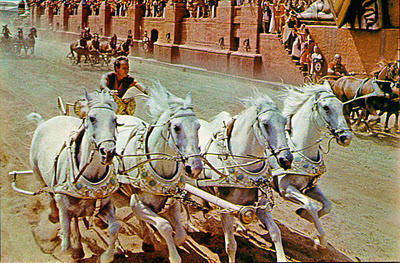
Hello My Friend and Welcome.MAGICAL MOVIE MOMENTSIf you've ever watched the chariot race sequence in the 1959 movie Ben Hur, you've arguably seen 17 minutes of the most dramatic movie footage ever shot. Ben Hur was the most expensive film ever made at its time. Costing $15 million and shot on a grand scale, it was a tremendous make-or-break risk for MGM Studios that ultimately saved the studio from bankruptcy. It required six years to prepare for the film shoot with over six months of on-location work in Italy. It featured more crew and extras than any other film before it — 15,000 alone for the chariot race. The scene is made all the more exciting when one realizes that Charlton Heston actually drove his own chariot during much of the filming. Those were the days, weren't they?The 1959 movie was the third screen adaptation of Lew Wallace's novel, Ben Hur: The Story of the Christ. It has also been made into a stage play several times. Wallace spent years compiling the research for the book that would become the best-selling American novel of the 19th Century. It was the first book to ever have a single press run of over a million copies and remained the best-selling American novel of all time until Gone with the Wind was released in 1936. Writing Ben Hur also changed its author, Lew Wallace. Somewhat indifferent to religion before writing the book, he said the act of writing Ben Hur produced "a conviction amounting to absolute belief in God and the divinity of Jesus Christ."
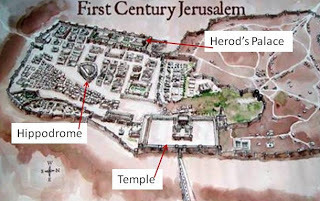 A Map of First Century JerusalemTHE TRUTH OF THE MATTERBut putting aside the book's success, the movie's enormous scale and its eleven Academy Awards, one still must ask, "How realistic was it." The plot sends Judah Ben Hur back to the land of his birth where he confronts his old nemesis and former friend, Messala, in a chariot race. This epic chariot race is depicted as taking place in, of all places, Jerusalem. Is there any historical justification for this scene? Could there really have held chariot races in the heart of Judaism and home to the Temple?
A Map of First Century JerusalemTHE TRUTH OF THE MATTERBut putting aside the book's success, the movie's enormous scale and its eleven Academy Awards, one still must ask, "How realistic was it." The plot sends Judah Ben Hur back to the land of his birth where he confronts his old nemesis and former friend, Messala, in a chariot race. This epic chariot race is depicted as taking place in, of all places, Jerusalem. Is there any historical justification for this scene? Could there really have held chariot races in the heart of Judaism and home to the Temple?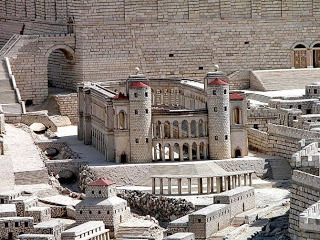 The Hippodrome from the SouthThe answer, in fact, is Yes. There's very good evidence that such a race could easily have taken place in Jerusalem. In addition to constructing a huge and magnificent palace in Jerusalem, and expanding and completely renovating the Temple, Herod the Great also built a Hippodrome, or racing stadium for the enjoyment of his friends. Despite his claim to be a Jew, Herod was thoroughly Roman in his lifestyle and chariot racing was one of Rome's oldest and most popular pastimes. CHARIOT RACING FROM THE INSIDE Pause occasionally as you read the following description and mentally revisit the chariot race as it was depicted in the movie. Hippodromes were built as a semi-circle with tiers of seats surrounding the U-shaped arena. An elaborate ornamented barrier, the spina, ran down the middle of the course defining the path of the race. Metae, or turning posts, adorned each end of the spina.
The Hippodrome from the SouthThe answer, in fact, is Yes. There's very good evidence that such a race could easily have taken place in Jerusalem. In addition to constructing a huge and magnificent palace in Jerusalem, and expanding and completely renovating the Temple, Herod the Great also built a Hippodrome, or racing stadium for the enjoyment of his friends. Despite his claim to be a Jew, Herod was thoroughly Roman in his lifestyle and chariot racing was one of Rome's oldest and most popular pastimes. CHARIOT RACING FROM THE INSIDE Pause occasionally as you read the following description and mentally revisit the chariot race as it was depicted in the movie. Hippodromes were built as a semi-circle with tiers of seats surrounding the U-shaped arena. An elaborate ornamented barrier, the spina, ran down the middle of the course defining the path of the race. Metae, or turning posts, adorned each end of the spina. At the start of the race, up to twelve four-horse chariots (quadrigae) lined up at the open end of the U. The charioteers circled the spina in a counter-clockwise path until they completed seven laps. Although they all started together, the ones on the outside would have to travel faster than the others. Like our modern track events, the teams gravitated to the shorter center lane as the race progressed. Mechanical devices known as the eagle and the dolphin were raised to signify that the race had begun, and lowered one by one to signify the number of laps remaining. Do you recall the man in the movie flipping them over as the charioteers roared around the track?
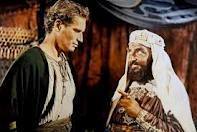 Negotiating with the Owner of the TeamAs depicted, the chariot driver typicallydid not own the horses, but like a modern jockey was a hired employee, or slave, of the horses' owner. Unlike the other sporting events of that day, charioteers did not perform in the nude…most probably for safety reasons and the likelihood of a crash. Racers wore a sleeved garment called a xystis. It reached down to the ankles and was cinched at the waist. Drivers wore a pair of straps across the upper back to prevent the xystis from ballooning up during the race.
Negotiating with the Owner of the TeamAs depicted, the chariot driver typicallydid not own the horses, but like a modern jockey was a hired employee, or slave, of the horses' owner. Unlike the other sporting events of that day, charioteers did not perform in the nude…most probably for safety reasons and the likelihood of a crash. Racers wore a sleeved garment called a xystis. It reached down to the ankles and was cinched at the waist. Drivers wore a pair of straps across the upper back to prevent the xystis from ballooning up during the race.Racing chariots were modified war chariots — basically a wooden cart with two wheels and an open back. The most exciting moments occurred at the turns around each end of the spina. This was where most collisions took place. If a charioteer lost control going into the turn, his rig could be overturned and he, along with his horses, crushed by other chariots rounding the post. Deliberately running into an opponent was technically illegal, but there was little that could be done in the middle of a race and, like the NASCAR circuit, accidents happened with grim regularity.
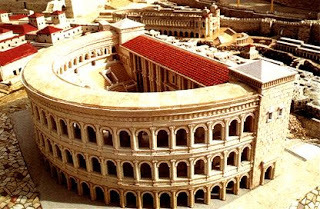 An Aerial View of the Hippodrome
An Aerial View of the HippodromeGIVE HIM AN A FOR ACCURACYClearly, Lew Wallace did his research well and the writers and directors of Ben Hur followed the historic record. We hope you enjoyed this nostalgic trip back to the era of the MGM movie spectacular. We'll return next Tuesday when we'll look at a device used by the Roman Army that has been called the Roman Telegraph.Until then, we wish Peace and Blessings.If you reached this post via a link, click the HOME tab above to see other posts and our archives.
Published on February 03, 2012 01:00
February 1, 2012
FOODS OF THE FIRST CENTURY - VEGETABLES
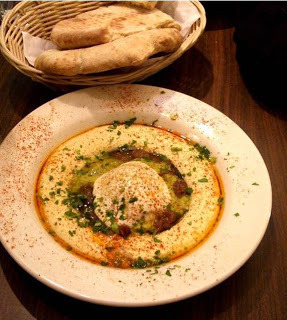 Flatbead and Hummus with Olive Oil and Spices
Flatbead and Hummus with Olive Oil and SpicesHello My Friend and Welcome.
Today we return to our ongoing series on the foods of the First Century…the items that Jesus, the Apostles and those first Christians consumed. As we have already seen, TV and the movies seldom portray an accurate image of that era. And so it is with the food also.
All too often they're either shown gathered around a campfire gazing hungrily at a side of lamb mounted on a spit. The alternate is having them sitting in hovels scooping glop out of unglazed bowls. True, Middle Eastern people often eat with their fingers or use flatbread in place of a spoon, but the region has a diverse and rich cuisine that goes far beyond glop. At the end of this series I plan to devote a post to what foods they didn't have, but for now, let's not be too quick to sell them short.
As always, we'll start with the Bible.

Beans (2 Samuel 17:28; Ezekiel 4:9) These would have been Fava beans, also known as broad beans or horse beans. Like all beans they can be eaten fresh or dried and reconstituted later. The beans can be sautéed in olive oil with garlic and or onion then mashed and eaten on bread. Favas are also cooked with onion and parsley and served as a stew. Mashed, they become a substitute for chickpeas in hummus.
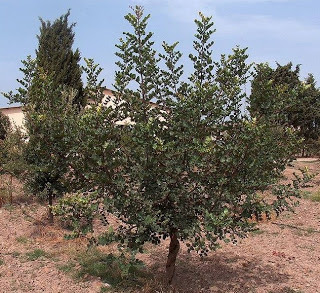 A Carob TreeCarob isn't mentioned in the Bible, but would have been available. The carob tree (Hebrew: חרוב ḥaruv; Greek: χαρουπιά haroubia), Ceratonia siliqua, is a species of flowering evergreen shrub or tree in the pea family that is native to the Mediterranean region. It is cultivated for its edible seed pods. Carobs are also known as St. John's bread; according to tradition St. John the Baptist subsisted on them in the wilderness. Carob was eaten in Ancient Egypt and used as a common sweetener before the arrival of sugar. Though not named, carob may appear in the Bible. The Prodigal Son wanted to eat the pods he fed the swine…most likely carob pods.
A Carob TreeCarob isn't mentioned in the Bible, but would have been available. The carob tree (Hebrew: חרוב ḥaruv; Greek: χαρουπιά haroubia), Ceratonia siliqua, is a species of flowering evergreen shrub or tree in the pea family that is native to the Mediterranean region. It is cultivated for its edible seed pods. Carobs are also known as St. John's bread; according to tradition St. John the Baptist subsisted on them in the wilderness. Carob was eaten in Ancient Egypt and used as a common sweetener before the arrival of sugar. Though not named, carob may appear in the Bible. The Prodigal Son wanted to eat the pods he fed the swine…most likely carob pods.  Fried ChickpeasChickpeas, also known as garbanzo beans, have been cultivated in the Middle East for 7,500 years and would have been one of the vegetables of ancient Israel that isn't mentioned in the Bible. Chickpeas are most commonly associated with hummus, however, they can be eaten fresh or dried for storage. Sprouted seeds are eaten as a vegetable or salad. Young plants and green pods are eaten like spinach. The leaves yield an indigo-like dye. Flour made from dried chickpeas when mixed with water and olive oil can be baked into a thin, crispy cracker.
Fried ChickpeasChickpeas, also known as garbanzo beans, have been cultivated in the Middle East for 7,500 years and would have been one of the vegetables of ancient Israel that isn't mentioned in the Bible. Chickpeas are most commonly associated with hummus, however, they can be eaten fresh or dried for storage. Sprouted seeds are eaten as a vegetable or salad. Young plants and green pods are eaten like spinach. The leaves yield an indigo-like dye. Flour made from dried chickpeas when mixed with water and olive oil can be baked into a thin, crispy cracker. Cucumbers (Numbers 11:5) Cucumbers would be enjoyed fresh in various ways just as they are today. Pickled, they would keep for a long time in a crock of vinegar.
Gourds (2 Kings 4:39) This passage from Kings tells the story of a man finding a wild vine, gathering gourds from it, and chopping them into a stew. It goes on to say they were poisonous. Elisha purified the stew so it could be eaten. Clearly the gourds must have been green or they couldn't have been sliced. The gourds I'm familiar with can be dried and their hard outer shell used for a number of purposes…dippers, bird feeders, bird houses, rattles or shakers, decorative hangings, etc. I'm confident that gourds were used a dippers and so on, but much more skeptical that they were eaten.

Leeks (Numbers 11:5) I've always thought of leeks as the onion's kinder, gentler cousin. Both plants belong to the same family. Unlike the onion, leeks don't form a tight bulb. They are typically eaten in soups and stews. Dried, they can be rehydrated or chopped fine and used as an herb.
 Multi-Colored LentilsLentils (Genesis 25:34; 2 Samuel 17:28; Ezekiel 4:9) Lentils, along with beans and peas, are in the pulse family… seeds of plants belonging to the family Leguminosae, which gets its name from the characteristic pod or legume that protects the seeds while they are forming and ripening. Pulses are a valuable food source because they contain a higher percentage of protein than most other plant foods. Dried lentils store very well. They are easier to prepare than dried beans since they require no pre-soaking and cook in an hour or less. They can be cooked into a simple stew, or spiced up with onions, peppers and cumin and served on bread, or sprouted.
Multi-Colored LentilsLentils (Genesis 25:34; 2 Samuel 17:28; Ezekiel 4:9) Lentils, along with beans and peas, are in the pulse family… seeds of plants belonging to the family Leguminosae, which gets its name from the characteristic pod or legume that protects the seeds while they are forming and ripening. Pulses are a valuable food source because they contain a higher percentage of protein than most other plant foods. Dried lentils store very well. They are easier to prepare than dried beans since they require no pre-soaking and cook in an hour or less. They can be cooked into a simple stew, or spiced up with onions, peppers and cumin and served on bread, or sprouted. Onions (Numbers 11:5) Onions can be pulled from the ground when immature and eaten green. Mature they can be used fresh or hung to dry for storage.

Peas, or field peas as they're known, would have been another food of the First Century. Peas are one of the oldest cultivated crops and wild varieties can still be found in parts of the Middle East. Pease can be eaten fresh, or dried and stored. Another pulse, they are high in protein.
We mentioned pulses, or legumes, earlier. Legumes provide food, medicines, oils, chemicals, timber, dyes and ornamental garden plants. Legume products include carob, senna, gum arabic, balsam, indigo and licorice. The next post in this series will look at Grains.
Next time, we'll look at Chariots in Jerusalem.Until then, we wish you Peace and Blessings
If you reached this post via a link, click the HOME tab above to see other posts and our archives.
Published on February 01, 2012 01:00
January 30, 2012
THE FLAVIAN AMPHITHEATRE or THE ROMAN COLISEUM
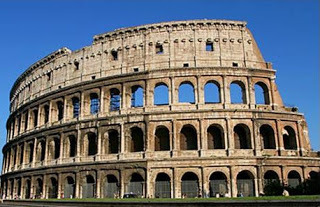
Hello My Friend and Welcome.
HAVE A LITTLE FUNDo you teach Sunday school or other religious education classes? If so, here's a surefire way to have some fun and grab everyone's attention. First, pose a question along the lines of: "I'll describe a scene and you tell me where it's taking place. We have thousands of Jewish slaves laboring in the hot sun under cruel taskmasters. They're lugging massive blocks of stone to build a monument that immortalizes their oppressor."
Hands shoot up around the room. At least half the class has seen Cecile B DeMille's The Ten Commandments and, though they didn't know the answer to that one about Elijah and Elisha, they've got this one nailed. "It's the Jews in Egypt," they shout.
Now it's time to spring the trap. "Wrong! This scene is taking place in Rome and those Jewish slaves are building the Flavian Amphitheater." You're met with blank stares. Since no one's ever heard of the Flavian Amphitheater, you now call it by its more common name: The Roman Coliseum.
THE EMPEROR VESPASIANTitus Flavius Vespasianus, known as Vespasian, was the ninth Roman Emperor and founder of the short-lived Flavian dynasty, which ruled the Roman Empire between 69 and 96 AD. It encompassed the reigns of Vespasian (69–79), and his two sons Titus (79–81) and Domitian (81–96). Vespasian was Governor of Syria when the great Jewish revolt began in 66. He led the forces against the Jews for three years before becoming Emperor. Heading to Rome, he left his son, Titus, in charge. Titus directed the siege and eventual destruction of Jerusalem. He returned to Rome triumphant with over 20,000 Jewish slaves who were put to work constructing the new Amphitheater that came to be known as the Coliseum.
Vespasian began construction in 72 AD and the building was completed in 80 AD, a year after his death. The huge amphitheater was built on the site of what had been an artificial lake. The lake was part of the park Nero constructed after the great fire of Rome. It also included his Domus Aurea, or Golden House, and a statue of Nero as the Colossus. The proximity of this giant statue of Nero gave the Flavian Amphitheater its popular name.
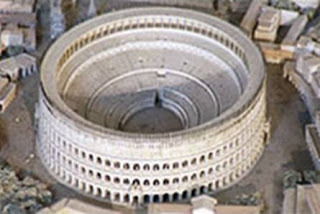
The building is immense, forming a 616 by 512 foot ellipse and rising to a height of more than 150 feet. The Coliseum accommodated up to 75,000 spectators who entered the building through no less than 80 entrances. The seating consisted of four levels. Just as in modern stadiums, the lowest section was reserved for the Emperor, his retinue and other prominent citizens. The upper levels accommodated the lower classes with special sections designated for men and for women. Below ground was a labyrinth of rooms and corridors with mechanical devices and cages containing wild animals. The cages could be hoisted, enabling the animals to suddenly appear in the middle of the arena.
THE FIRST DOMED STADIUMPredating our domed stadiums by nearly 2,000 years, the Coliseum was covered with an enormous awning known as the velarium. This not only protected the spectators from the sun, it focused light on the arena. It was supported by large poles attached along the top rim and anchored to the ground by large ropes. A team of 1,000 men was required to rig and extend the awning.
A hundred days of games were held by Vespasian's successor, Titus, to mark the inauguration of the building in AD 80. In the process, some 9,000 wild animals were slaughtered. The south side of the Coliseum collapsed during an earthquake in 847 leaving it as we see it today. Parts of the building, including its marble façade, were removed and re-used for the construction of other buildings in Rome, including the St. Peter's Basilica.
Next time we'll continue our Foods of the First Century posts with a look at vegetables.
Until then, we wish you Peace and Blessings.If you reached this post via a link, click the HOME tab above to see other posts and our archives.
Here's a video about the Roman Colisuem you may enjoy:
Published on January 30, 2012 01:00
January 27, 2012
WADI SIKAIT - ROME'S EMERALD CITY
 Dorothy and Her Friends Head Off to the Emerald CityHello My Friend and Welcome.
Dorothy and Her Friends Head Off to the Emerald CityHello My Friend and Welcome. Some of our favorite posts are those that range widely, connecting seemingly unrelated places and events in a memorable way. Hopefully, today's qualifies. In a moment you'll understand why we chose the image of Dorothy and her friends skipping along the Yellow Brick Road on their way to the Emerald City to meet the Wizard of Oz.
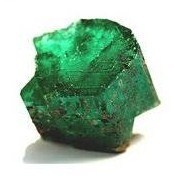 The Carolina EmperorFINDING THE CAROLINA EMPERORBut first, let's examine the impetus for today's post…a recent news article about an exceptional 65 carat emerald that was found near a cornfield in North Carolina. They're calling it the Carolina Emperor. It compares in size and quality to one surrounded by diamonds in a brooch once owned by Catherine the Great that Christie's auction house in New York sold for $1.65 million. And to think that the man's father used to charge people $3.00 a day to dig around and see what they could find. Bet he's glad no one stumbled upon this whopper.
The Carolina EmperorFINDING THE CAROLINA EMPERORBut first, let's examine the impetus for today's post…a recent news article about an exceptional 65 carat emerald that was found near a cornfield in North Carolina. They're calling it the Carolina Emperor. It compares in size and quality to one surrounded by diamonds in a brooch once owned by Catherine the Great that Christie's auction house in New York sold for $1.65 million. And to think that the man's father used to charge people $3.00 a day to dig around and see what they could find. Bet he's glad no one stumbled upon this whopper.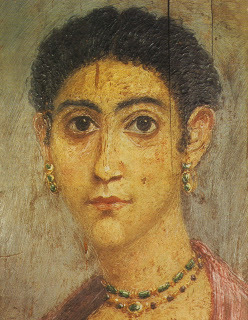 Roman Woman Wearing an Emerald Necklace
Roman Woman Wearing an Emerald NecklaceROMAN WOMEN FAVORED SMARAGDINow it just so happens that among precious stones, emeralds ranked very high on the Roman's popularity chart. Today, the world's best quality emeralds are found in Columbia. Emeralds are also mined in Afghanistan, Australia, Brazil, India, Madagascar, Pakistan, Russia, South Africa, Zambia, Zimbabwe and, of course, in North Carolina. A quick review of that list pretty much eliminates the Roman Empire. North and South America, Madagascar and Australia were unknown to the Romans. Rome's power extended into the northern regions of Africa, but the nations mentioned in the list are all in the extreme south. Rome traded with modern India, but primarily for spices, not gemstones.
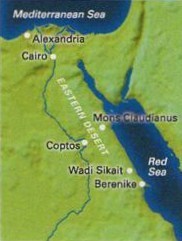 So how did that the Romans satisfy their desire for emeralds? Instead of a yellow brick road to Oz, let's follow a sandy trail across the trackless desert wastes of Eastern Egypt to the ancient region of Wadi Sikait, Rome's Emerald City, or Mons Smaragdus—Emerald Mountain. The first thing we see from the map is Wadi Sikait's close proximity to the port city of Berenike. As we learned in a recent post on Foods of the First Century, Berenike was a major debarkation point for Indian spices coming into the Roman Empire, especially pepper. Jute bags of peppercorns along with emeralds traveled from this Red Sea port overland by camel caravan to the Nile, then by boat to Alexandria, and from there to Rome via merchant ship. If you missed the one on Spices & Herbs you can find HERE.
So how did that the Romans satisfy their desire for emeralds? Instead of a yellow brick road to Oz, let's follow a sandy trail across the trackless desert wastes of Eastern Egypt to the ancient region of Wadi Sikait, Rome's Emerald City, or Mons Smaragdus—Emerald Mountain. The first thing we see from the map is Wadi Sikait's close proximity to the port city of Berenike. As we learned in a recent post on Foods of the First Century, Berenike was a major debarkation point for Indian spices coming into the Roman Empire, especially pepper. Jute bags of peppercorns along with emeralds traveled from this Red Sea port overland by camel caravan to the Nile, then by boat to Alexandria, and from there to Rome via merchant ship. If you missed the one on Spices & Herbs you can find HERE.Pliny the Elder, in his Natural History, addresses the legend, lore and gossip of emeralds, which the Romans called smaragdi. Referencing gems from the Eastern Desert, which he calls them Egyptian or Ethiopian stones, he says they were "so hard as to be unaffected by blows." Romans valued emeralds above all gems except diamonds and pearls. Pliny also writes, "I have seen Lollia Paulina, who became the consort of Gaius (we know him as Caligula) covered with emeralds and pearls interlaced and shining over her head, hair, ears, neck and fingers, the sum total amounting to a value of 40,000,000 sesterces." Quite an image, isn't it? To put this into better perspective, recall that a soldier's annual wage at that time was around 1,200 sesterces.
DO IT YOURSELF EMERALDSLike anything of high value, unscrupulous merchants attempted to counterfeit emeralds. Pliny denounced the practice and told how, "There are treatises by authorities describing how, by means of dyestuffs, emeralds and other transparent colored gems are made from rock crystal… And there is no other trickery practiced against society with greater profit." Some things apparently never change. It is standard practice today to oil emeralds to disguise their flaws.
LOST FOR OVER A THOUSAND YEARSWadi Sikait was the sole source of emeralds for the Romans. The area flourished, which explains why the Romans called the region Emerald Mountain. Unbelievably, the location of the site was eventually lost. In 1816, Mohammed Ali Pasha, the Ottoman Viceroy to Egypt, set out to find the fabled lost emerald mines of the Romans. He sent Fédéric into the desert to find them. It took him three years, but in 1817 Cailliaud re-discovered the mines.
In his journals Cailliaud spoke of finding a site that contained a beehive like structure consisting of "perhaps a thousand excavations" with long underground causeways interconnecting them to facilitate communication. They were built in such a way that camels could move through the passageways bringing the workmen provisions. He marveled at the labor it would have taken to construct such a complex.
Unable to explore the mines himself, he continued on and three-and-a-half miles from there discovered an abandoned town. The Bedouins of the area called the place Sekket (Sikait) Bendar El Kebyr. He found 500 houses hewn from the native stone and three temples cut into the sides of the mountains. He spoke of wandering the deserted dwellings and finding "various instruments, utensils…fired clay lamps." He found fragments of vases "of beautiful form" made of both bisque and glass. Cailliaud discovered stone grinding mills still waiting for grain…an entire town "hitherto unknown to all voyagers, which had not been inhabited, perhaps, for 2,000 years and almost entirely standing. In fact, the area had been abandoned only about 1,300 years. Roman mining ceased there somewhere around the year 500 …a date that coincides nicely with Edward Gibbons date of 476 for the Fall of The Roman Empire.
NO LONGER ECONOMICALLY FEASIBILEDespite Cailliaud success in finding the ancient site, the mines were never re-opened. The heat and the terrain proved too severe and the stones then being mined in South America were superior to those available at Wadi Sikait. One reason for the lower quality could be that the best stones were already removed during Roman times. The Roman writer Strabo, when writing his Geography in the First Century, states that the Arabs dug ever deeper tunnels in their quest to extract emeralds.
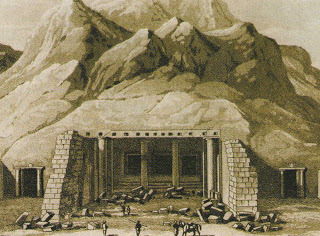 One of Cailliaud's DrawingsCailliaud made several pen and ink drawings of the temples he discovered. Based on current photos of the same buildings, there has either been a lot of destruction during the intervening years or, more likely, his depictions present a fanciful image of how the buildings appeared during Wadi Sikait's heyday. Note the rather significant differences between current reality and his drawing of the temple façade in the photo below.
One of Cailliaud's DrawingsCailliaud made several pen and ink drawings of the temples he discovered. Based on current photos of the same buildings, there has either been a lot of destruction during the intervening years or, more likely, his depictions present a fanciful image of how the buildings appeared during Wadi Sikait's heyday. Note the rather significant differences between current reality and his drawing of the temple façade in the photo below. 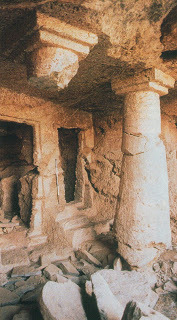
WADI SIKAIT AND PETRASeeing Wadi Sikait immediately brought Petra to my mind. Petra, the ancient city of rock, is in a much better state of preservation, but anyone familiar with this former capital of the Nabateans can't help but be reminded of it when viewing Cailliaud's drawings. Located in what is now the country of Jordan, Petra predates Wadi Sikait by six centuries.
Like Petra, Wadi Sikait, was a city in the desert. Also like Petra, its principal structures are carved out of the rock face with the interior of the buildings cut into the mountainside. This method of construction was undoubtedly used to combat the temperature extremes of a desert environment.
SURVIVAL IN THE HARSH CLIMATEArchaeological expeditions in the last fifteen years have found the remains of many of the mines around Mons Smaragdus. Still, the area elicits more questions than answers. Working conditions must have been, to say the least, brutal. Winter temperatures range into the 90's, sometimes higher, and can drop into the 30's at night. Archaeologists also report that there were days when their thermometers didn't go high enough to register the afternoon temperatures.
How the people survived day-to-day remains unclear. Researchers have found several ancient wells, but whether they produced sufficient water is impossible to say. There is some evidence that fruit and vegetables were grown on site, but wine, oil, meat (did it come on the hoof or dried and salted?) and fish would have to have been brought in. Other excavations have found evidence that transport animals, especially donkeys, were slaughtered for food. Was that part of an overall plan or does it indicate periods of scarcity?
Experts also do not know if emeralds were mined before control of Egypt passed into Roman hands in 30 BC. Study of potsherds, however, suggests that Wadi Sikait's history dates back to the First Century…shortly after Egypt became a Roman Province.
Next time we'll look at Rome's Flavian Amphitheatre…more commonly called the Coliseum.
Until then, we wish you Peace and Blessings.
If you reached this post via a link, click the HOME tab above to see other posts and our archives.
Published on January 27, 2012 01:00
January 25, 2012
VISITING THE CAVE CHURCH IN ANTIOCH
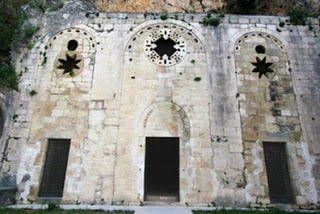 Exterior of the Cave Church or St Peter's GrottoHello My Friend and Welcome.
Exterior of the Cave Church or St Peter's GrottoHello My Friend and Welcome. If you're a frequent visitor, you've probably grown familiar with the cave-like image in our masthead. What you may not know is that the photo in the upper left of your screen is from the Cave Church, or St. Peter's Grotto in Antioch (now Antakya). It is believed to have been dug out by St. Peter himself and used as a place of worship by the early Christian community in Antioch. This would make it the very first Christian Church ever built.
ANTIOCH: AN EARLY CENTER OF CHRISTIANITYAntioch, of course, became the primary center of the early church after the Christians were dispersed from Jerusalem by persecution. Connected by the Orentes River to the Mediterranean port of Pieria Seleucia, it quickly became a major center of planning and organization the missionary efforts throughout Asia Minor and beyond. Luke, the Evangelist, was a native of Antioch and Peter, Paul, Barnabus and others used it as both a jumping off place and a safe haven to which they could return between journeys.
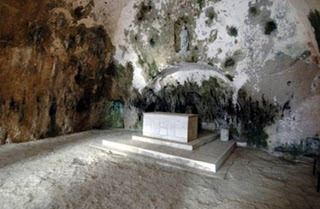 Inside: The Altar
Inside: The AltarThe interior of the grotto is austere. Its few permanent items consist of a simple altar, a single statue, and a stone chair or seat. Deposits from years of seepage can be seen on the wall behind the altar. Some of the walls have the barely discernible remnants of ancient frescoes and the floor indicates traces of mosaics. Despite its simplicity, one can't look at the photo of the interior without being awed by the holiness it exudes.
RESCUED BY THE CRUSADERS
The exterior stone façade of the church was built by Crusaders who identified the grotto during their rule of Antioch from 1098 to 1268. There is a tunnel in the back that leads into the mountain's interior. It is believed to have been used as a place of hiding during times of persecution. As we learned in last week's post, Antioch has experienced many severe earthquakes over the centuries and the Turkish Government now restricts access to the Grotto Church because of seismic instability.
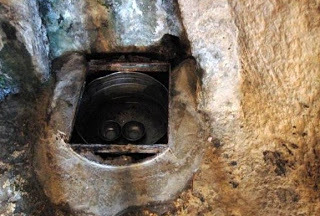 The Bapistry: A Natural Indentation Gathered Water from a SpringA scene dealing with the development of the Cave Church by the new Christians appears in my novel, Disciple. For those who are interested, I've posted a short excerpt. Click HERE to read it.
The Bapistry: A Natural Indentation Gathered Water from a SpringA scene dealing with the development of the Cave Church by the new Christians appears in my novel, Disciple. For those who are interested, I've posted a short excerpt. Click HERE to read it.
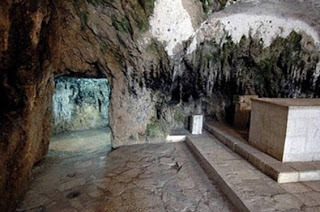 The Side Exit Where Christians are Believed to Have EscapedNext time, we will take a trip to Wadi Sikait, Rome's Emerald City.
The Side Exit Where Christians are Believed to Have EscapedNext time, we will take a trip to Wadi Sikait, Rome's Emerald City.Until then, we wish you Peace and Blessings.If you reached this post via a link, click the HOME tab above to see other recent posts and visit our archives.
Published on January 25, 2012 01:00
January 23, 2012
THE ANTIOCH EARTHQUAKE THAT DESTROYED THE QUEEN OF THE EAST
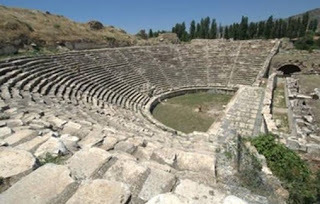 Ruins of Ampitheatre in Antioch
Ruins of Ampitheatre in AntiochHello My Friend and Welcome.
Today we're going to visit the ancient city of Antioch on the Orentes. In the First Century Roman world Antioch, with a population of more than half a million, was justifiably famous for its beauty, a leader in trade and culture as well as an important military outpost. Antioch rivaled Alexandria, the second city of the Roman Empire. Today, Rome, Italy has a population of 3.7 million and 4.1 million people call Alexandria, Egypt home. Meanwhile Antakya, Turkey, once the seat of the Christian Church, has a population of only 140,000. Why?
ANTIOCH'S HISTORYAntioch on the Orontes, also known as Antioch of Syria, was situated on the eastern side of the Orontes River in the far southeastern corner of Asia Minor. When the city was founded in 300 BC by Seleucus I Nicator, he urged Jews to move there from Jerusalem. The city quickly developed a large Jewish population. As was his policy in all the cities he founded, Seleucus I granted these Jews equal rights of citizenship along with the Macedonians and the Greeks. Several ancient sources tell us that the Antiochene Jews, having a governor of their own and comprising a large percentage of the population, exerted as great an influence there as they did in Alexandria.
Christianity came to Antioch following the persecution that resulted in Stephen's death. The new faith was preached to and accepted by the Greeks of the city and it was there that the name Christian originated. The Church exhibited great enthusiasm and became the base of the missionary journeys of Paul, Barnabus, Silas and others.
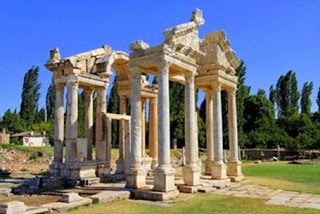 Entance to the Temple of Aphrodite
Entance to the Temple of AphroditeJust as Ephesus gloried in the Temple of Artemis, Antioch was home to the main Temple of Aphrodite…the Aphrodisias. Interestingly enough, though typically associated with seduction and sexuality, the statue of Aphrodite was clothed in a heavy cloak that disguised her figure and a long veil covered her face. So much for the images of gauzy lingerie Aphrodite's name conjures up.
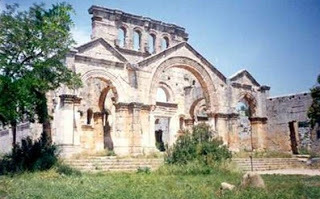 Remains of Church of St. Simeon
Remains of Church of St. SimeonCHURCH OF ST. SIMEONThe city was also famous for the Church of St. Simeon, a native saint who lived in the Fifth Century. It consisted of four basilicas radiating from the sides of a central octagon. With over 16,000 square feet of floor space, it nearly equaled the more famous Hagia Sophia in Constantinople. The church was only one part of a huge, walled complex that included a monastery, two lesser churches, and several large hostels.
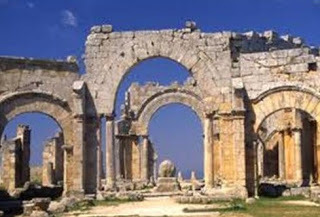 The Tetrapylon, or Monumental Gate Antioch was also known for the Tetrapylon, or monumental gate. The ancient Greeks placed great importance on the location and orientation of architecture. Thus the main axis of the city was aligned with the distant mountains and the Tetrapylon was at one end of this axis. The city also had a large theater/stadium and the Museion, a complex on the island between the arms of the Orentes River devoted to the arts.
The Tetrapylon, or Monumental Gate Antioch was also known for the Tetrapylon, or monumental gate. The ancient Greeks placed great importance on the location and orientation of architecture. Thus the main axis of the city was aligned with the distant mountains and the Tetrapylon was at one end of this axis. The city also had a large theater/stadium and the Museion, a complex on the island between the arms of the Orentes River devoted to the arts. THE QUEEN OF THE EAST MEETS A DISASTROUS ENDTrue many of Antioch's architectural treasures now stand in ruins, but even in their current state their former grandeur is readily apparent. So why did Rome and Alexandria prosper while Antioch languished? The answer to that question can be found in a single event that occurred in the year 526.
Late in May of that year, sometime between the 20th and the 29th, a major earthquake struck Antioch and the surrounding area. On the Modified Mercalli Scale, it is estimated to have registered VIII (Destructive) at Antioch, the epicenter, and VII (Very Strong) at Daphne and Seleucia Pieria. The port of Seleucia Pieria experienced an uplift of between two to three feet. The subsequent silting up of the harbor left it unusable. The raging fire which followed destroyed any buildings in Antioch that survived the earthquake. In all, approximately 250,000 people died. It still ranks as the 3rd most deadly earthquake of all time.
Given the extent of the damage and the area's known seismic instability, the decision was made to abandon the city rather than attempt to rebuild. What a sad end for Antioch, the Queen of the East.
Next time we'll be examining another Antioch landmark. Known as the Cave Church, its image graces the header on the Sowing the Seeds Blog. It is considered to be the oldest Christian Church in the world.
Until then, we wish you Peace and Blessings.
If you reached this post via a link, click the HOME tab above to see other posts and our archives.
Published on January 23, 2012 01:00
January 19, 2012
CHRISTIAN WRITER'S BLOG CHAIN — QUEST
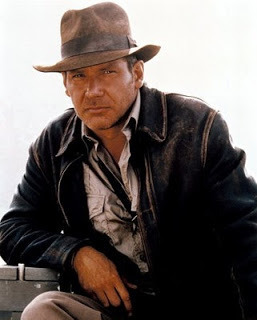 Who Goes on a Cool Quest Better than Indiana Jones?Hello My Friend and Welcome.
Who Goes on a Cool Quest Better than Indiana Jones?Hello My Friend and Welcome.Today is our monthly turn in the hot seat of the Christian Writer's Blog Chain. The topic for this month is Quest, and as usual, I'll be looking at it through the lens of writing and the writing life. We authors know all about quests because the fundamental principle of all writing is that there is something the character doesn't have, desperately wants, and intends to get.
The story then details their quest to achieve this elusive goal. Sometimes that goal can be as grandiose as the Holy Grail, Solomon's Lost Mine, or a Ring of unbelievable power. At other times it can less concrete, such as the triumph of good over evil. It can be as mundane as finding a suitable marriage partner or catching the dastardly villain who killed dear old Mrs. McTavish.
It is against this backdrop of an overarching quest that our characters and subplots come to life. It's not unusual to hear an author say something along the lines of, "My characters are doing all sorts of things I never intended." On the surface, such a statement is patently absurd. As authors we are the puppeteer and our characters the marionette. Without us, they remain lifeless dolls, bits of painted wood, fabric and string in a dusty box. They can do nothing until we sit down at the keyboard and pull their strings. It is this Godlike power to bring the inanimate to life and orchestrate its thoughts, desires and actions that makes the creative process so intoxicating. Authors are the ultimate magicians, seemingly creating something out of nothing.
Does this mean the poor author is forced to sit in his gloomy garret tapping out stories while his characters pursue their quest for grand adventures? No. While the characters race around the world chasing villains, retrieving treasures, and rescuing damsels in distress, the author's quest remains closer to home. The author's role, their quest, if you will, is to mine the character and bring them to their fullest expression. Since much of this work occurs on the subconscious level, characters sometimes seem to have a mind of their own.
In truth, our confounded author should have said, "I am amazed at the breadth and depth I've been able to bring to this character. My inner creativity has enlarged them as individuals and increased their contribution to the story beyond anything I imagined when I first created them." Doesn't have quite the same ring as characters rising up off the page and demanding more lines and additional scenes, or else!
Some writing courses encourage participants to create a sheet listing a character's attributes as an aid to character development. Their age, appearance, education, ethnicity, strengths, weaknesses, life goals and so on. This is something I have never done. I find it more applicable to casting a movie than populating a book.
Hollywood has casting professionals whose sole responsibility is to fill the empty slots with believable actors. If someone hired you to cast a movie, the first thing you'd have to know is what kind of a person they're looking for. Being a visual medium, movies demand the actor look the part. Think of the above photo of Harrison Ford as Indiana Jones; imagine Ernest Borgnine in the same role.
Consider also that the first thing a method actor asks is, "What are the character's motivations?" As casting director, you can whip out your character sheet and tell them. Authors never face such a dilemma. Our swashbuckling hero always fits the bill because we designed him that way. Our shy damsel is as pure as driven snow because we said she was. If we'd wanted her to be a vamp, she would have been.
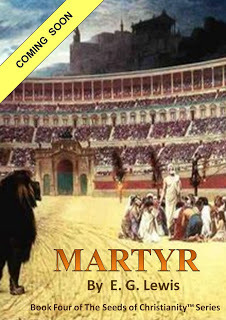 As I approach the conclusion of my four-book Seeds of Christianity Series, I find myself nostalgically looking back at the various characters who've gone on this quest with me. The ones who had co-starring roles.
As I approach the conclusion of my four-book Seeds of Christianity Series, I find myself nostalgically looking back at the various characters who've gone on this quest with me. The ones who had co-starring roles. Interestingly, only two members of the supporting cast appeared in all four books. They were Rivkah's youngest son, Yudah, and Atticus, the black slave and assistant to Roman Physician, Evodius Scipio, who eventually becomes a Tribune.
Like Atticus, most started small and grew, returning in the following book. Others have come on stage, played their part well, and then left. Rivkah's father, Yaakov, slipped away once she grew up. Eleana, the Christian girl in Disciple who was brutally raped by a Roman soldier and considered, but rejected, an abortion, seemed like someone who would return but didn't
The last book in the Series, Martyr. has two unique characters, Janus, the traitor who exposes his fellow Christians and Rhebekka, the young woman Rivkah's son, Yudah, marries. Rhebekka is a character near and dear to my heart. We gave Yudah a pretty hard time in Apostle, being suspected as a serial killer and all, so he deserved a sweet girl to marry. And he got one.
Earlier I called authors the ultimate magicians, who seemingly create something out of nothing. From the outside it no doubt appears that way. However, those of us on the inside know it isn't that simple. Godlike power brings Godlike responsibilities. Last month we spoke of the need to tell true stories. Our stories can never be true unless, like God, we put a little of ourselves into each of our creations.
On Monday, we'll take a look at the earthquake that destroyed Antioch, the Queen of the East.
Until then, we wish you Peace and Blessings. If you reached this post via a link, click the HOME tab above to see other posts and our archives.
Published on January 19, 2012 01:00



